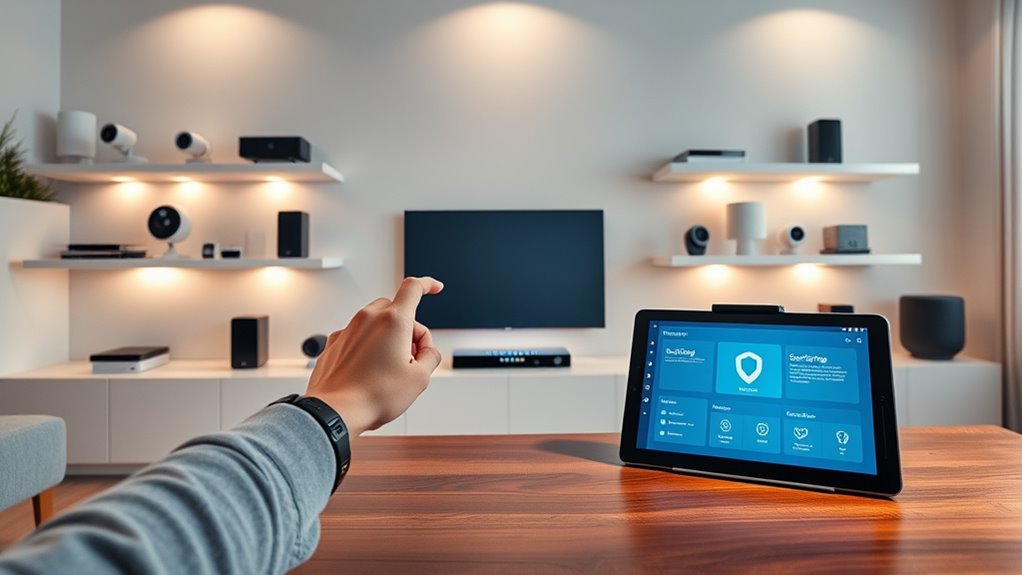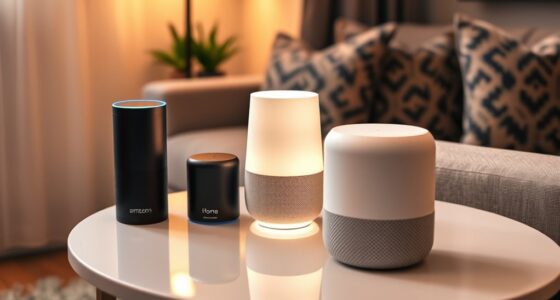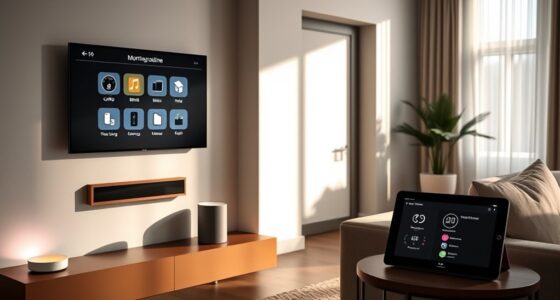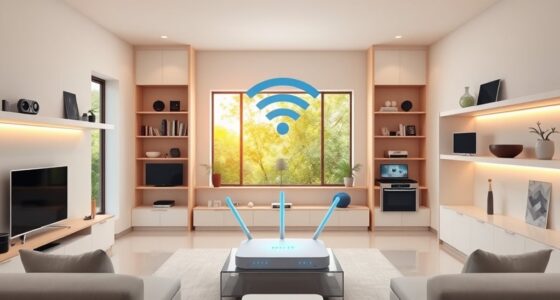To secure your smart home, start by using strong, unique passwords and changing default ones immediately. Enable encryption protocols like WPA3 and keep your device firmware updated to patch vulnerabilities. Create separate networks for your IoT devices and personal devices to limit access. Regularly review permissions, disable unused features, and follow manufacturer updates. Staying proactive with these practices helps protect your devices from threats. If you want to know more, there’s much more to explore to keep your smart home safe.
Key Takeaways
- Enable strong encryption protocols like WPA3 and keep device firmware updated regularly.
- Change default passwords and use unique, complex login credentials for each device.
- Segment your network by placing smart devices on a separate Wi-Fi network from personal devices.
- Regularly install firmware updates and security patches to fix vulnerabilities.
- Review device permissions, disable unused features, and follow ongoing cybersecurity best practices.

As smart home devices become more common, guaranteeing your connected home stays secure is more important than ever. The convenience of controlling your lights, thermostats, cameras, and locks remotely comes with the responsibility of protecting your data and privacy. One of the most effective ways to do this is by understanding and implementing proper security measures, starting with encryption protocols and managing user access.
Encryption protocols are essential in safeguarding the data transmitted between your devices and your network. When you connect a smart device, it often communicates over the internet, which exposes it to potential interception or hacking. By guaranteeing your devices support strong encryption protocols, like WPA3 for Wi-Fi or TLS for data transfer, you considerably reduce the risk of unauthorized access. These protocols scramble the information so that even if someone intercepts the data, they can’t read it without the encryption key. Always keep your devices’ firmware up to date, as manufacturers often release security patches that strengthen encryption and fix vulnerabilities.
Using strong encryption protocols like WPA3 and TLS is key to protecting your smart home data.
User access controls are equally crucial. Your smart home ecosystem should have strict settings that limit who can access and control your devices. Change default passwords immediately, and create unique, strong passwords for each device or account. Avoid sharing your login credentials casually, and consider setting up separate user profiles if your system allows it. Many smart home platforms let you assign different permissions, so family members or guests can have limited access without compromising your entire system. Regularly review who has access and revoke permissions for anyone who no longer needs it. Two-factor authentication adds an extra layer of security, making it harder for intruders to gain entry even if they have your password.
Another good practice is to segment your network. Keep your smart devices on a separate Wi-Fi network from your computers and smartphones. This way, even if a device is compromised, the attacker can’t easily access your personal or financial data stored on other devices. Use strong, unique passwords for your Wi-Fi and enable network encryption to keep your entire home network protected. Additionally, privacy policies and cookie management can help you understand how your data is handled and ensure your privacy preferences are respected.
Finally, stay informed about potential security threats and best practices. Follow updates from your device manufacturers and cybersecurity experts. Regularly review your device settings, update passwords, and disable features you don’t use. By actively managing encryption protocols and user access, you make it much harder for hackers to exploit vulnerabilities and protect your smart home from intrusion. Your proactive approach guarantees that your connected home remains a safe, convenient space for everyone living there.
Frequently Asked Questions
How Can I Detect Unauthorized Access to My Iot Devices?
To detect unauthorized access to your IoT devices, you should start with network monitoring to spot unusual activity or traffic spikes. Implement device authentication to guarantee only trusted devices connect. Regularly review device logs and update firmware. Using a robust security system helps you identify and respond to potential threats quickly. Staying vigilant with these practices keeps your smart home safer and prevents unauthorized access before it causes harm.
What Are the Signs That My Smart Home Has Been Compromised?
If your smart home has been compromised, you might notice unusual device behaviors, unexpected network activity, or difficulty controlling your devices. These signs could point to device vulnerabilities being exploited. Stay alert and increase user awareness by regularly updating firmware and changing passwords. Monitoring your network for unfamiliar connections helps detect intrusions early. Trust your instincts—if something feels off, investigate further to protect your smart home from potential threats.
How Often Should I Update My Iot Device Firmware?
Some might think firmware updates are optional, but they’re essential for your device security. You should update your IoT device firmware as soon as updates are available, ideally once a month. Regular firmware updates patch vulnerabilities, improve performance, and guarantee your devices stay protected from cyber threats. Keeping your firmware current is a simple yet effective way to maintain your smart home’s security and safeguard your personal information.
Are There Specific Brands More Secure Than Others?
When choosing IoT devices, you should consider brand reputation and device compatibility. Some brands have a better track record for security, releasing timely firmware updates and maintaining strong privacy policies. Look for reputable brands that prioritize security features and make certain of compatibility with your existing smart home setup. This way, you reduce vulnerabilities and enjoy a safer, more reliable smart home experience.
What Legal Rights Do I Have if My Iot Devices Are Hacked?
Oh, the bliss of owning a smart device—until it gets hacked! If that happens, you have legal recourse and consumer protections, but they vary. You might be able to sue the manufacturer for negligence or breach of warranty. Check your rights under consumer protection laws, which could offer compensation or remedies. Remember, just because your smart gadget is clever, doesn’t mean it’s immune to legal accountability.
Conclusion
Just like locking your front door keeps intruders out, securing your IoT devices protects your home from unseen threats. Remember, a single weak link can open the door to hackers, much like leaving a window unsecured invites trouble. Stay vigilant—update passwords, enable two-factor authentication, and keep firmware current. Think of your smart home as a fortress; a small effort now can prevent a costly breach later. Protecting your devices is protecting your peace of mind.









